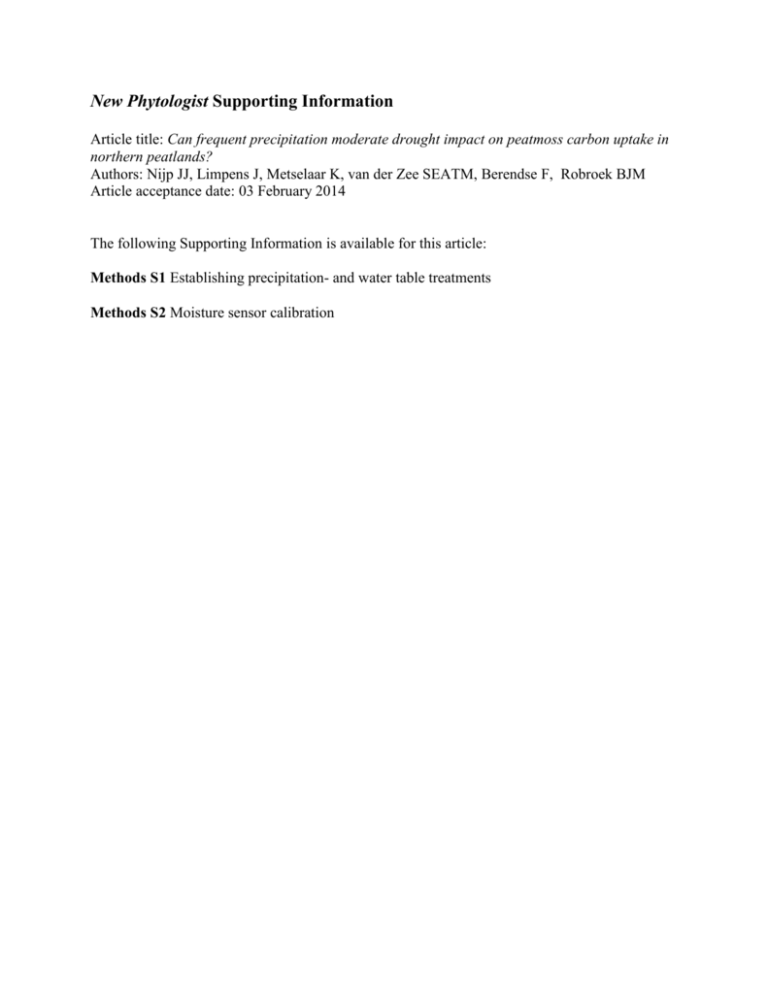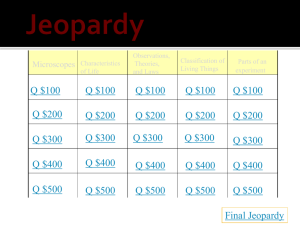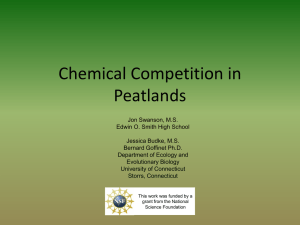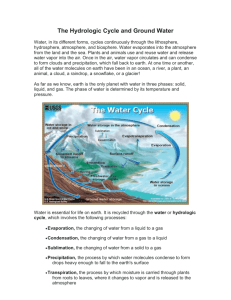nph12792-sup-0001-MethodS1-S2
advertisement

New Phytologist Supporting Information Article title: Can frequent precipitation moderate drought impact on peatmoss carbon uptake in northern peatlands? Authors: Nijp JJ, Limpens J, Metselaar K, van der Zee SEATM, Berendse F, Robroek BJM Article acceptance date: 03 February 2014 The following Supporting Information is available for this article: Methods S1 Establishing precipitation- and water table treatments Methods S2 Moisture sensor calibration Methods S1 Establishing precipitation- and water table treatments Precipitation frequency The average daily precipitation amount was set to compensate for daily water loss by evaporation from the peat moss surface. Based on the Penman-Monteith model (Penman, 1953; Monteith, 1965), meteorological conditions in the climate chamber and a crop coefficient (a factor to translate evapotranspiration from a reference crop to evapotranspiration from a Sphagnum surface) of 0.77 (Kellner, 2001), the potential evaporation (Ep) in the climate chamber was estimated at 2 mm d-1. Equal potential evaporation rates were assumed for the three Sphagnum species. To simulate natural precipitation, a realistic precipitation intensity and duration were derived from a thermodynamically based relationship between precipitation intensity, duration and frequency following Dahlström (2006): 𝑅 = 200 𝜏 1/3 ln(∆𝑡)/∆𝑡 , Eqn S1 where R is precipitation intensity (L s-1 ha-1), τ is the return period (months) and Δt is the precipitation duration (min). A return period of 5 years was selected. For each precipitation frequency treatment, R and Δt in Eqn S1 were chosen such that R · Δt corresponded with the precipitation amount for the given precipitation treatment (Table 1). The treatment averaged precipitation intensity was then used for all precipitation frequency treatment levels to calculate a new precipitation duration given the required amount of precipitation to cover expected cumulative evaporative losses. Water table treatments Water retention cylinders were developed to be able to impose deep water tables. The functioning of the water retention cylinders (WRC’s) is analogous to the principle of the sandbox, a standard procedure in soil hydrology to obtain the water retention characteristic (e.g. Klute, 1986). The WRC consisted of a PVC cylinder (ID 20 cm, height 20 cm) filled with two layers of sand separated by a filter cloth. The upper layer consisted of 6 cm fine sand (D50 130 µm) and the bottom layer consisted of 4 cm very coarse sand (D50 1045 µm). With the particle size of the fine sand a water table of 60 cm could be simulated by applying a suction of 60 cm. Both sands were low in iron- and magnesium oxides (Fe2O3 < 0.21%; MgO < 0.10%) and have a low acid buffering capacity (1.06 mmol H+ per kg dry soil is required to raise the H+ concentration with 1 mmol H+; see for protocol in Scheffer & Schatschabel, 1989). The sand is therefore assume to not alter water quality or affect moss performance significantly. A drainage tube installed in the coarse sand is connected to the groundwater reservoir which is used to control the groundwater level. Lowering this reservoir results in drainage of water from the mesocosm in the WRC into the groundwater reservoir. If the water level exceeds the overflow threshold, water is transported to a drainage reservoir (Fig. 2). Evaporation from the moss surface will result in a decrease of water level in the groundwater reservoir. The decrease in water level of the groundwater reservoir activates the Mariotte bottle which replenishes the groundwater reservoir. To prevent evaporation from the free sand surface surrounding the mesocosm in the water retention cylinder, reflective isolation material was placed in the space between the mesocosm and the WRC. This guarantees that the suction pressure established in the WRCs is not affected by this evaporation and that no additional loss term needs to be included in the water balance. Connection between water table treatments and field conditions From soil physical perspective, the fine sand in WRCs can differ from peat in (i) the water retention function and (ii) the (unsaturated) hydraulic conductivity function. As a consequence of these differences, experimental conditions could conceivably not be translated to field conditions. In this section we aim to demonstrate that treatment conditions established in the climate chamber experiment can be translated to field conditions. Water retention The fine sand in the setup was used, together with adjusting the position of the groundwater reservoir, to apply suction to the Sphagnum mesocosms in the WRCs. The suction pressure is an applied physical quantity, affects water retention of the living moss layer, and is identical for experimental- and field conditions. Suction pressure is controlled by atmospheric conditions and water table. With similar atmospheric conditions in the climate chamber and in the field, suctions (i.e. water tables) applied with WRCs result in the same moisture contents in both situations. Hydraulic conductivity Throughout the experiment the WRCs remained saturated. Given that the saturated hydraulic conductivity of the fine sand is much larger (1-10 m d-1) than a representative evaporative demand of about 0.002 m d-1, the hydraulic conductivity of the sand in the WRC will not limit water transport from the WRC towards the living moss layer. At a suction of 25 cm, the unsaturated hydraulic conductivity of the living moss layer is 0.0035 m d-1 (Price & Whittington, 2010). Consequently, the hydrophysical characteristics of the unsaturated living moss layer control water transport from the groundwater reservoir to the moss surface and not the underlying fine sand. Altogether, differences in hydrophysical characteristics between the WRC sand and Sphagnum peat material under field conditions are unlikely to affect water content and -transport in the living moss layer. The water table treatments established with the WRCs are therefore representative for field conditions. Methods S2 Moisture sensor calibration The moisture sensors (EC5-H2O, Decagon Devices, Pullman, WA, USA), which were used to obtain time series of volumetric water content (VWC), provided a voltage output (mV), which had to be converted into VWC. Although calibration functions are available for Sphagnum (Yoshikawa et al., 2004) the dielectric properties of is likely to differ among Sphagnum species. Moreover it is recommended to perform site specific calibrations for Sphagnum moss (Yoshikawa et al., 2004). To increase the accuracy of the VWC measurements we therefore conducted a calibration experiment in which saturated peat cores were subjected to drying. Sphagnum cores (inner diameter 15 cm, height 10 cm) of each species (S. fuscum [n = 3], S. balticum [n = 2], S. majus [n = 3]) were taken as described in the Methods section. To prevent air entrapment, the cores were saturated from below for 24 h. Here, saturation was defined as a groundwater level (in the Sphagnum core) approximating the peat moss surface as near as possible. After saturation, each core was placed on a balance and an EC5-H2O moisture sensor (Decagon Devices, Pullman, WA,USA) was installed horizontally at a depth of 3 cm below the peat moss surface with tines flat, representing the average water content of the upper 1-5 cm. In this set up the weight and moisture sensor voltage output during drying of each core were logged every 15 minutes with a CR1000 datalogger (Campbell Scientific, Logan, UT, USA). Accordingly, for each point in time, the gravimetric water content (GMC) and sensor voltage output were known. At the end of the calibration experiment, samples were oven dried for 48 h at 70 °C to obtain the bulk density (ρb) , which was used to transform gravimetric water contents at time i to volumetric water contents (Eqn S2.1). We assumed that the error in VWC caused by shrinkage of the Sphagnum matrix was of minor importance. 𝑉𝑊𝐶𝑖 = 𝐺𝑊𝐶𝑖 𝜌𝑏 Eqn S2.1 At the start of the experiment some samples were oversaturated, as a thin layer of standing water was present due to the irregular moss surface. As a consequence VWC values larger than the saturated water content were calculated. For each sample, these water contents were removed. The saturated water content (θs) was defined as the total porosity (ϕt) and was calculated with Eqn S2.2, where ρp is the particle density of peat. 𝜌𝑏 Eqn S2.2 𝜃𝑠 = 𝜙𝑡 = 1 − 𝜌𝑝 The particle density was estimated at 1.6 g cm-3 for low humified Sphagnum peat (Heiskanen, 1995; Cannavo & Michel, 2013). Although the particle density might vary among species and with the commercially used Sphagnum peat, a 50% change in particle density resulted only in a 2% change of the total porosity. For each species, several functions relating sensor output to VWC were fitted with non-linear regression using a Gauss-Newton algorithm (nls package, R v2.13.0, R Core team). Based on RMSE and visual inspection the Weibull function (Eqn S2.3) fitted the data best and all parameters were significantly different from 0. 𝑉𝑊𝐶 = 1 − 𝐸𝐶 −𝛼 𝛾 −( 5 ) 𝛽 𝑒 Eqn S2.3 However, fitted water contents near saturation were structurally about 10-15% lower than the calculated total porosities and values for saturated water content of undecomposed Sphagnum (Cagampan & Waddington, 2008; Schlotzhauer & Price, 1999). To force the fit through more realistic saturated water contents, extra weight (half of the total number of observations) was added to the calculated saturated water contents. The weighted Weibull calibration functions fitted the data well, especially for S. balticum, where the mean difference between observed and modelled VWC was only 0.022. Table S.2.1. Parameter values for the Weibull calibration functions for relating EC5-H2O sensor output (mV) to volumetric water content (m3 H2O per m3 Sphagnum). All parameters were significant (P < 0.001). The goodness of fit of the calibration functions is given by the root mean square error (RMSE). Average saturated water contents estimated with Eqn 2.2 are presented in the column θs ± SE. Additionally the average bulk density ρb ± SE of the top 0 - 5 cm is given per species. ρb (g cm-3) θs (m m-3) RMSE (m3 m-3) S. fuscum 0.057 ± 0.001 0.982 ± 0.003 0.086 -660.3 ±50.6 1269.7 ±50.9 7.389 ±0.301 S. balticum 0.054 ± 0.001 0.981 ± 0.001 0.022 244.5 ±1.54 296.1 ±1.61 S. majus 0.064 ± 0.001 0.983 ± 0.001 0.064 -530.5 ±40.7 1153.6 ±40.9 7.486 ±0.267 Species 3 Parameter values (± 1 standard error) α β γ 1.930 ±0.010 References in Supporting Information Cagampan JP, Waddington JM. 2008. Moisture dynamics and hydrophysical properties of a transplanted acrotelm on a cutover peatland. Hydrological Processes 22: 1776-1787. Cannavo P, Michel JC. 2013. Peat particle size effects on spatial root distribution, and changes on hydraulic and aeration properties. Scientia Horticulturae 151: 11-21. Dahlström B. 2006. Regnintensitet i Sverige - en klimatologisk analys [Rain intensity in Sweden - a climatological analysis], Svensk Vatten AB. Heiskanen J. 1995. Physical properties of two-component growth media based on Sphagnum peat and their implications for plant-available water and aeration. Plant and soil 172: 4554. Kellner E. 2001. Surface Energy Exchange and Hydrology of a Poor Sphagnum Mire. Uppsala, Uppsala. Klute A. 1986. Methods of Soil Analysis. Part 1. Physical and Mineralogical Methods, Soil Science Society of America. Monteith JL. 1965. Evaporation and environment. Symposia of the Society for Experimental Biology, 19, 205-234. Penman HL. 1948. Natural evaporation from open water, bare soil and grass. Proceedings of the Royal Society of London 193: 120-146. Price JS, Whittington PN. 2010. Water flow in Sphagnum hummocks: Mesocosm measurements and modelling. Journal Of Hydrology 381: 333-340. Scheffer F, Schachtschabel P. 1989. Lehrbuck der bodenkunde, 12th edition, Stutgart. Schlotzhauer SM, Price JS. 1999. Soil water flow dynamics in a managed cutover peat field, Quebec: Field and laboratory investigations. Water Resources Research 35: 3675-3683. Yoshikawa K, Overduin PP, Harden JW. 2004. Moisture content measurements of moss (Sphagnum spp.) using commercial sensors. Permafrost Periglacial Processes 15: 309318.







